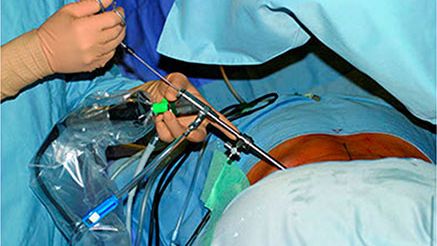Endoscopic Micro-discectomy
Minimal invasive surgical operation for removal of a hernia of intervertebral disc through small puncture using endoscope.
Published: 22.03.2018
The Institute of Traumatology and Orthopedics has successfully implemented a new method for hernia treatment – endoscopic micro-discectomy.
Endoscopic micro-discectomy is a minimal invasive surgical operation for removal of hernia of intervertebral disc through small puncture using endoscope. This innovative method ensures removal of any intervertebral disc hernias in lumbar spine without destabilization of spine or an intervertebral disc, as it is a frequent complication after open operations. Approach and technique allow complete removal of hernia and hypertrophy of joints. Special tools ensure excluding damages of nerves. It makes the operation not only the safest, but also the most efficient one. .

Advantages:
- Minimum trauma to the surrounding tissues;
- Fast recovery with minimal rehabilitation, quick returning to habitual life (3 days later);
- Low level of post-surgical pain that required very few anesthesia or allows refusing from it at all;
- Small section (less than 1 cm) promotes decrease in frequency of inflammatory complications and minimal blood loss;
- Local anesthesia neutralizes all the risks related to the general narcosis and ensures good general conditions after surgery;
- 1-2 days of in-hospital stay;
- Ideal for patients with contraindications to the open surgery or general anesthesia.
What is the difference of the method from traditional micro-discectomy?
Endoscopic surgery of spine demands no durable in-hospital stay, no general anesthesia, no big section, no long period of rehabilitation to return to ordinary life.
What are indications to endoscopic surgery of spine?
Hernias of intervertebral discs of different localization and foraminastenosis are the most frequent indications to endoscopic surgery.
Who is to be chosen for treatment?
- if you have lumbar back and/or leg pain connected to a spine hernia;
- if epidural steroid injections and conservative treatment are inefficient;
you are a candidate for endoscopic micro-discectomy.
About the procedure:
The procedure of endoscopic micro-discectomy requires local anesthesia. The patient remains in consciousness while the procedure and is able to ensure feedback for the surgical team. After making local anesthesia, a needle is inserted into the area adjacent to the disk involved. Unlike any other surgical interventions, micro-discectomy through a small section results in only smallest trauma of muscles and tissues surrounding the spine. For access to some hernias, special tool are applied to exclude traumatization of spine’s neural structures. The endoscope is a thin tube, and its diameter is similar to an ordinary pencil. Therein are camera, lighting and portal for special instruments.

Excellent visualization of the endoscope gives a doctor an opportunity to study spine anatomy and to identify the pain-causing elements. In such a way hernias are selectively removed, and healthy tissues remain on their place. The endoscope has open portal for the special micro-tools for probing, cutting and removal of pathologic elements. The whole procedure is controlled by fluoroscopic navigation, ensuring accurate and safe placement of all the necessary instruments. After the end of the procedure and removal of the endoscope, only 1 suture is required. 2 hours after surgery the patient can stand up and service himself / herself with minimum limitations and is released from the hospital in the evening of the same day or next day in the morning.
- Tag:
- endoscopic micro-discectomy
- endoscopic micro-discectomy in Ukraine
- endoscopic micro-discectomy Kyiv